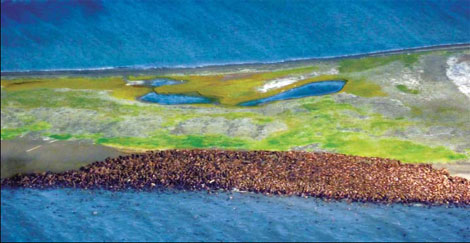Society
Reduced sea ice forces walruses to shore
Updated: 2011-08-23 08:02
(China Daily)
|
Pacific walruses gather on the northwest coast of Alaska. Provided to China Daily |
Large herds of Pacific walrus have begun gathering on the northwest coast of Alaska, again forsaking sea ice for sand in what has become a symbol of climate warming in the region.
A contractor taking part in federal marine mammal aerial surveys over the Chukchi Sea spotted about 5,000 walruses on Aug 17 on a beach north of Point Lay. A second herd of 3,000 walruses rested a short distance away.
In winter, Pacific walruses are found at the edge of sea ice in the Bering Sea. Older males remain in the Bering Sea for the summer, but mothers and their young ride the edge of sea ice as it melts north through the Bering Strait and into the Chukchi Sea.
Female walruses and their young have come ashore during late summer and fall in four of the last five years on Alaska's northwest coast. The phenomenon began after sea ice melted far beyond the relatively shallow continental shelf to waters of the deep Arctic Basin.
Walrus can dive to 182 meters to find clams, snails and other food on the ocean bottom. Water beyond the continental shelf can be 3,050 meters or more.
In 2007, several thousand walruses gathered on Alaska's northwest shore for the first time. They returned in 2009, and last year gathered in unprecedented numbers. Upward of 20,000 animals were counted near Point Lay, an Eskimo village 480 km southwest of Barrow and 1,125 km northwest of Anchorage.
Walrus face danger from stampedes when they gather on shore. More than 130 mostly young walruses were crushed in September 2009 at Alaska's Icy Cape in a disturbance that could have been caused by a polar bear, human hunters or an airplane.
"Walrus are sensitive to human activity and to machine activity," says US Fish and Wildlife Service spokesman Bruce Woods.
Woods says the herds could continue to grow. Sea ice in Arctic waters generally melts through mid-to late September. "We could see bigger concentrations," he says.
The walruses were spotted by a COMIDA flight, which stands for Chukchi Offshore Monitoring in Drilling Area. The aerial surveys are funded by the Bureau of Ocean Energy Management, Regulation and Enforcement, which oversees offshore petroleum drilling, and coordinated by the National Marine Mammals Laboratory.
US Geological Survey scientists planed to be in Point Lay last week to tag 35 walruses with satellite radio tags that will monitor foraging activity from shore. The tracking project is part of a study on how walruses respond to reduced sea ice.
Associated Press

Specials

Biden Visits China
US Vice-President Joe Biden visits China August 17-22.

Star journalist leaves legacy
Li Xing, China Daily's assistant editor-in-chief and veteran columnist, died of a cerebral hemorrhage on Aug 7 in Washington DC, US.

Hot pots
Tea-making treasures catch the fancy of connoisseurs as record prices brew up interest
